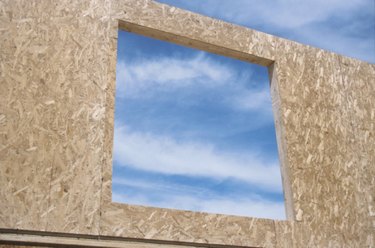
Particle board must be protected from moisture or the wood particles will get wet, expand and begin flaking away. The edges of the boards and holes where the nails or screws are fastened must be sealed before painting begins. The adhesive holding the wood particles together will yellow or discolor paint, so a stain-blocking wood primer must be applied before the finish coat. Painting the walls with a brush and roller is the most common approach.
Step 1
Caulk the seams or joints between the particle boards using a caulking gun. Cut the tip off a tube of caulk with a utility knife and load the tube into the caulking gun. Place the tip of the tube into a joint and squeeze the trigger until caulking flows out. Slide the gun down the joint as the bead of caulk is applied. Go over the bead of caulk with you finger to smooth it out and seal the joint. Wipe off excess caulk on a wet painter's rag.
Video of the Day
Step 2
Fill the nail or screw holes in the particle board with wood putty using a stiff putty knife. Scoop a blob of putty out of the putty tub and then press the putty into the hole with the broadside of the blade. Repeat this process until all holes are filled. Wait 24 hours and sand the puttied holes smooth with a 100-grit sanding block.
Step 3
Pour one-half gallon of stain-blocking wood primer paint into a five-gallon bucket and 3 inches of paint into a hand-held paint holder. Hang a paint roller screen from the inner lip of the five-gallon bucket.
Step 4
Dip a paintbrush into the paint in the handheld paint holder and paint the boarders of the walls. Paint the boarder around the wall 4 inches wide with the paintbrush. The idea is to paint the areas of the wall with the brush where the roller won't be able to reach.
Step 5
Slip a 1-inch nap roller cover over the spindle of the roller frame and screw an extension pole into the handle of the roller frame.
Step 6
Dip the roller into the paint in the five-gallon bucket until the nap is loaded with primer. Paint each wall with the roller from left to right and from top to bottom. Roll down the wall a few feet and then back up the wall, overlapping the first pass by a couple of inches. Paint a few feet at a time until the entire wall is primed. Wait 24 hours and apply a finish coat following the same procedure.
Tip
Particle board is a porous surface and may require more than one finish coat for proper hiding coverage.
Video of the Day